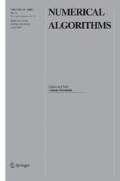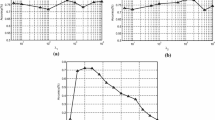Abstract
Symmetric nonnegative matrix factorization (symNMF) is a variant of nonnegative matrix factorization (NMF) that allows handling symmetric input matrices and has been shown to be particularly well suited for clustering tasks. In this paper, we present a new model, dubbed off-diagonal symNMF (ODsymNMF), that does not take into account the diagonal entries of the input matrix in the objective function. ODsymNMF has three key advantages compared to symNMF. First, ODsymNMF is theoretically much more sound as there always exists an exact factorization of size at most n(n − 1)/2 where n is the dimension of the input matrix. Second, it makes more sense in practice as diagonal entries of the input matrix typically correspond to the similarity between an item and itself, not bringing much information. Third, it makes the optimization problem much easier to solve. In particular, it will allow us to design an algorithm based on coordinate descent that minimizes the component-wise ℓ1 norm between the input matrix and its approximation. We prove that this norm is much better suited for binary input matrices often encountered in practice. We also derive a coordinate descent method for the component-wise ℓ2 norm, and compare the two approaches with symNMF on synthetic and document datasets.


Similar content being viewed by others
References
Abraham, B., Naomi, S.M.: Completely Positive Matrices. World Scientific (2003)
Beck, A.: First-Order Methods in Optimization, vol. 25. SIAM (2017)
Berman, A., Plemmons, R.J.: Nonnegative Matrices in the Mathematical Sciences, vol. 9. SIAM (1994)
Bertsekas, D.: Corrections for the book nonlinear programming (1999)
Bertsekas, D.: Nonlinear Programming, 2nd edn. Athena Scientific, Massachusetts (1999)
Borsdorf, R., Higham, N.J., Raydan, M.: Computing a nearest correlation matrix with factor structure. SIAM J. Matrix Anal. Applic. 31(5), 2603–2622 (2010)
Chen, Y., Rege, M., Dong, M., Hua, J.: Non-negative matrix factorization for semi-supervised data clustering. Knowl. Inf. Syst. 17(3), 355–379 (2008)
Cichocki, A., Zdunek, R., Phan, A.H., Amari, S.i.: Nonnegative matrix and tensor factorizations: Applications to exploratory multi-way data analysis and blind source separation. Wiley (2009)
Dickinson, P.J., Gijben, L.: On the computational complexity of membership problems for the completely positive cone and its dual. Comput. Optim. Applic. 57(2), 403–415 (2014)
Fortunato, S.: Community detection in graphs. Phys. Rep. 486 (3–5), 75–174 (2010)
Fu, X., Huang, K., Sidiropoulos, N.D., Ma, W.K.: Nonnegative matrix factorization for signal and data analytics: Identifiability, algorithms, and applications. IEEE Signal Process. Mag. 36(2), 59–80 (2019)
Gillis, N.: The why and how of nonnegative matrix factorization. In: Suykens, J., Signoretto, M., Argyriou, A. (eds.) Regularization, Optimization, Kernels, and Support Vector Machines, chap. 12, pp 257–291. Chapman & Hall/CRC, Boca Raton (2014)
Gillis, N., Hien, L.T.K., Leplat, V., Tan, V.Y.: Distributionally robust and multi-objective nonnegative matrix factorization. arXiv:1901.10757 (2019)
Gillis, N., Vavasis, S.A.: On the complexity of robust pca and ℓ1-norm low-rank matrix approximation. Math. Oper. Res. 43(4), 1072–1084 (2018)
Gionis, A., Mannila, H., Tsaparas, P.: Clustering aggregation. ACM Trans. Knowl. Discov.from Data (TKDD) 1(1), 4–es (2007)
Gurwitz, C.: Weighted median algorithms for l1 approximation. BIT 30(2), 301–310 (1990)
Huang, K., Sidiropoulos, N.D., Swami, A.: Non-negative matrix factorization revisited: Uniqueness and algorithm for symmetric decomposition. IEEE Trans. Signal Process. 62(1), 211–224 (2013)
Kuang, D., Ding, C., Park, H.: Symmetric nonnegative matrix factorization for graph clustering. In: Proceedings of the 2012 SIAM International Conference on Data Mining, pp. 106–117. SIAM (2012)
Kuang, D., Yun, S., Park, H.: Symnmf: Nonnegative low-rank approximation of a similarity matrix for graph clustering. J. Glob. Optim. 62(3), 545–574 (2015)
Long, B., Zhang, Z.M., Wu, X., Yu, P.S.: Relational clustering by symmetric convex coding. In: Proceedings of the 24th international conference on Machine learning, pp. 569–576. ACM (2007)
Peng, Z., Wu, T., Xu, Y., Yan, M., Yin, W.: Coordinate-friendly structures, algorithms and applications. Ann. Math. Sci. Applic. 1(1), 57–119 (2016)
Pham, Q.M., Lachmund, D., Hào, D. N.: Convergence of proximal algorithms with stepsize controls for non-linear inverse problems and application to sparse non-negative matrix factorization. Numerical Algorithms (2020)
Pompili, F., Gillis, N., Absil, P.A., Glineur, F.: Two algorithms for orthogonal nonnegative matrix factorization with application to clustering. Neurocomputing 141, 15–25 (2014)
Shi, Q., Sun, H., Lu, S., Hong, M., Razaviyayn, M.: Inexact block coordinate descent methods for symmetric nonnegative matrix factorization. IEEE Trans. Signal Process. 65(22), 5995–6008 (2017)
Strehl, A., Ghosh, J., Mooney, R.: Impact of similarity measures on web-page clustering. In: Workshop on Artificial Intelligence for Web Search (AAAI 2000), vol. 58, p. 64 (2000)
Vandaele, A., Gillis, N., Lei, Q., Zhong, K., Dhillon, I.: Efficient and non-convex coordinate descent for symmetric nonnegative matrix factorization. IEEE Trans. Signal Process. 64(21), 5571–5584 (2016)
Wright, S.J.: Coordinate descent algorithms. Math. Program. 151(1), 3–34 (2015)
Yan, X., Guo, J., Liu, S., Cheng, X., Wang, Y.: Learning topics in short texts by non-negative matrix factorization on term correlation matrix. In: proceedings of the 2013 SIAM International Conference on Data Mining, pp. 749–757. SIAM (2013)
Yang, Z., Hao, T., Dikmen, O., Chen, X., Oja, E.: Clustering by nonnegative matrix factorization using graph random walk. In: Advances in Neural Information Processing Systems, pp. 1079–1087 (2012)
Zass, R., Shashua, A.: A unifying approach to hard and probabilistic clustering. In: Tenth IEEE International Conference on Computer Vision (ICCV’05), vol. 1, pp. 294–301. IEEE (2005)
Zhang, Z., Li, T., Ding, C., Zhang, X.: Binary matrix factorization with applications. In: Seventh IEEE International Conference on Data Mining (ICDM 2007), pp. 391–400. IEEE (2007)
Zhong, S., Ghosh, J.: Generative model-based document clustering: A comparative study. Knowl. Inf. Syst. 8(3), 374–384 (2005)
Funding
This work is supported by the Fonds de la Recherche Scientifique - FNRS and the Fonds Wetenschappelijk Onderzoek - Vlanderen (FWO) under EOS Project no O005318F-RG47, and by the European Research Council (ERC starting grant no 679515)
Author information
Authors and Affiliations
Corresponding author
Additional information
Publisher’s note
Springer Nature remains neutral with regard to jurisdictional claims in published maps and institutional affiliations.
Appendix: The constrained weighted median problem
Appendix: The constrained weighted median problem
Algorithm 7 provides a pseudocode to compute the solution to the constrained weighted median problem:
The algorithm works as follows:
-
The set S of breakpoints \(\frac {b_{i}}{a_{i}}\) is initialized for all i = 1,...,n such that ai≠ 0 (because when ai = 0, the contribution of the i th term in the objective function is a constant) and the vector a is then sorted and normalized according to the values in S,
-
As the values ai correspond to the slopes, the second step of the algorithm looks for the k th breakpoint for which we have \({\sum }_{i=1}^{k-1} a_{i} < {\sum }_{i=k}^{n} a_{i}\) and \({\sum }_{i=1}^{k} a_{i} \geq {\sum }_{i=k+1}^{n} a_{i}\). It corresponds to a global optimum since the slope on the left is negative, and on the right is nonnegative.

Rights and permissions
About this article
Cite this article
Moutier, F., Vandaele, A. & Gillis, N. Off-diagonal symmetric nonnegative matrix factorization. Numer Algor 88, 939–963 (2021). https://doi.org/10.1007/s11075-020-01063-9
Received:
Accepted:
Published:
Issue Date:
DOI: https://doi.org/10.1007/s11075-020-01063-9




